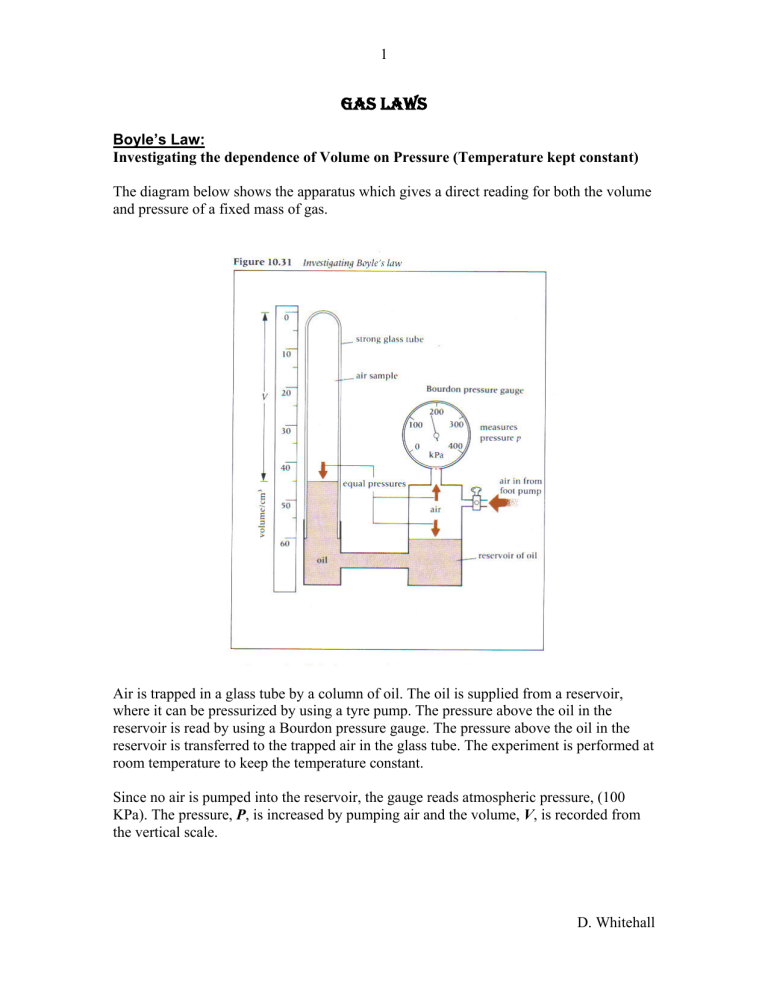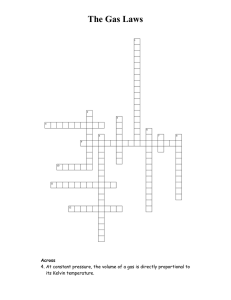
1 GAS LAWS Boyle’s Law: Investigating the dependence of Volume on Pressure (Temperature kept constant) The diagram below shows the apparatus which gives a direct reading for both the volume and pressure of a fixed mass of gas. Air is trapped in a glass tube by a column of oil. The oil is supplied from a reservoir, where it can be pressurized by using a tyre pump. The pressure above the oil in the reservoir is read by using a Bourdon pressure gauge. The pressure above the oil in the reservoir is transferred to the trapped air in the glass tube. The experiment is performed at room temperature to keep the temperature constant. Since no air is pumped into the reservoir, the gauge reads atmospheric pressure, (100 KPa). The pressure, P, is increased by pumping air and the volume, V, is recorded from the vertical scale. D. Whitehall 2 The graphs below demonstrate the relationship between pressure, P, and Volume, V. This relationship is stated as Boyle’s Law: The volume of a fixed mass of gas is inversely proportional to its pressure if the temperature is constant. Boyle’s Equation: P1 V1 = P2 V2 D. Whitehall 3 Charles’ Law: Investigating the variation of the Volume of a gas with Temperature (Pressure kept constant) The diagram below shows the apparatus which gives a direct reading for both the volume and temperature of a fixed mass of gas. A column of air is trapped by a bead of concentrated sulfuric acid in a capillary tube. The tube was then attached to a half-meter rule by using rubber bands. This apparatus is placed inside of a beaker containing water and it is kept upright by using a clamp-stand. The water surrounding the capillary tube is heating with a bunsen burner, while stirring with the thermometer. The readings of the thermometer, T, and the volume, V, were taken at 15oC intervals. D. Whitehall 4 The graphs below demonstrate the relationship between Volume, V, and Temperature, T. This relationship is stated as Charles’ Law: The volume of a fixed mass of gas is directly proportional to its absolute temperature (on the Kelvin scale) if the pressure is constant. Charles’ Equation: V1 = V2 T1 T2 D. Whitehall 5 Pressure Law: Investigating the variation of the Pressure of a gas with Temperature (Volume kept constant) The diagram below shows the apparatus which gives a direct reading for both the pressure and temperature of a fixed mass of gas. The apparatus consists of a large flask filled with dry air connected by pressure tubing to a Bourdon pressure gauge. The bulb is placed inside a large container and is completely filled with water. The pressure of the air is recorded over a wide range of temperatures including 0oC and 100oC. The graphs below demonstrate the relationship between Pressure, P, and Temperature, T D. Whitehall 6 This relationship is stated as Pressure Law: The pressure of a fixed mass of gas is directly proportional to its absolute temperature if its volume is constant. Pressure Equation: P1 = P2 T1 T2 D. Whitehall 7 Gas Law: Gas Law Equation: P1V1 = T1 P2 V 2 T2 The Kelvin Scale These gas laws and additional experiments led Lord Kelvin to propose a temperature scale. This Ideal Gas Temperature Scale is known as the Kelvin Scale of temperature and 0 K or -273oC is often called “absolute zero”. The relationship between the Kelvin scale and the Celsius scale T = oC + 273 D. Whitehall 8 KINETIC THEORY Brownian Motion The motion of tiny suspended particles is called Brownian motion. This is easily observed in both liquid and gases. The illuminated smoke particles which are seen when viewed through a microscope appear as bright specks moving in a jerky and erratic manner. The particles do not collide frequently with each other, but seem to be struck by some other invisible particles. It is believed that these other particles are particles of air (or water) used to suspend the particles. This evidence suggests that particles exist and that they are constantly moving in all directions with different speeds. D. Whitehall 9 Brownian motion is easily observed with smaller particles than larger particles, this is because the movement of larger particles is too low to be observed. The effect of Brownian motion can be enhanced with increase in temperature. Increasing the temperature causes the average speed of the molecules to increase, therefore the chances of collisions also increases since the particles have more momentum. PHYSICAL PROPERTIES OF SOLIDS, LIQUIDS AND GASES Read and make notes (also include diagrams) on: PFC Page 151 - 156 the three states of matter a model gas, liquid and solid forces on molecules in a liquid stretching materials (solids) PFC Page 184 - 185 evaporation vapour pressure evaporation and boiling effect of pressure on boiling D. Whitehall 10 Gas Pressure Gas pressure can be explained in terms of moving molecules. Molecules in gases are far apart and move rapidly filling in available spaces. As they move, they collide with the walls of the container making a large number of collisions per second. The force exerted on the walls produces gas pressure. Gas Pressure and Laws Explanation in Terms of Kinetic Theory D. Whitehall 11 D. Whitehall





